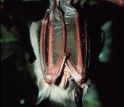News Release 04-120
Ecology of Infectious Diseases Grants Awarded by National Science Foundation, National Institutes of Health

Adult Neoplatymops mattogrossensis (New World flat-headed bat) from Northeast Brazil.
September 15, 2004
This material is available primarily for archival purposes. Telephone numbers or other contact information may be out of date; please see current contact information at media contacts.
ARLINGTON, Va.—The National Science Foundation (NSF) and the National Institutes of Health (NIH) have announced funding for six projects under the Ecology of Infectious Diseases (EID) program, the fifth year of funding in this multi-year effort. The joint program supports efforts to understand the ecological and biological mechanisms that govern relationships between human-induced environmental changes and the emergence and transmission of infectious diseases.
Interdisciplinary projects funded through the EID program will study how large-scale environmental events—such as habitat destruction, biological invasion and pollution—alter the risks of viral, parasitic and bacterial diseases emerging in humans and animals.
"Over the past 20 years, unprecedented rates of change in non-human biodiversity have coincided with the emergence and re-emergence of numerous infectious diseases around the world," said Sam Scheiner, EID program director at NSF. "The coincidence of broad-scale environmental changes and the emergence of infectious diseases may point to underlying and predictable ecological relationships."
Yet both basic and applied research in infectious disease ecology has been largely piecemeal, said Scheiner. According to infectious disease specialists and ecologists, the potential benefits of an interdisciplinary research program in this area include: development of disease transmission theory; improved understanding of unintended health effects of development projects; increased capacity to forecast outbreaks; and improved understanding of how diseases emerge and re-emerge. Previous research looked only at diseases after they reached humans or only at non-human animals. The EID program links those different components to produce a comprehensive understanding of disease transmission.
"We're trying to put scientists, public health officials and environmental planners in the driver's seat rather than in a reactive mode for disease control," said Josh Rosenthal, program director at NIH's Fogarty International Center, which co-funded the research.
The need for increased understanding is being driven by the increased pace of global change, society's greater global mobility and the threat of the deliberate release of disease organisms. By knowing how natural systems work, public health officials can recognize when an outbreak is unnatural. The recent outbreaks of West Nile Virus and SARS show how little is known about the ecology of infectious diseases.
This year's EID awards include studies of the ecology, dynamics and spatial spread of raccoon rabies in places such as Fairfax County, Virginia; the link between marine pathogens and molluscan shellfish; the effects of deforestation on the prevalence of blood-borne pathogens in African rainforest birds; ecological influences on rabies infections in bats; the epidemiological dynamics of cholera; and the eco-epidemiology of disease emergence in urban areas.
For more information on the EID program, and on this year's EID grant awards, please see: http://www.nsf.gov/bio/pubs/awards/eid.htm
-NSF-
-
Juvenile Stenoderma rufum (red fig-eating bat), a species endemic to Puerto Rico and surrounding ...
Credit and Larger Version
Note to journalists: For information on upcoming Lecture on Ecology of Infectious Diseases see: http://www.nsf.gov/od/lpa/news/04/ma0428.htm
Media Contacts
Cheryl Dybas, NSF, (703) 292-7734, email: cdybas@nsf.gov
Program Contacts
Sam Scheiner, NSF, (703) 292-8481, email: sscheine@nsf.gov
The U.S. National Science Foundation propels the nation forward by advancing fundamental research in all fields of science and engineering. NSF supports research and people by providing facilities, instruments and funding to support their ingenuity and sustain the U.S. as a global leader in research and innovation. With a fiscal year 2023 budget of $9.5 billion, NSF funds reach all 50 states through grants to nearly 2,000 colleges, universities and institutions. Each year, NSF receives more than 40,000 competitive proposals and makes about 11,000 new awards. Those awards include support for cooperative research with industry, Arctic and Antarctic research and operations, and U.S. participation in international scientific efforts.
Connect with us online
NSF website: nsf.gov
NSF News: nsf.gov/news
For News Media: nsf.gov/news/newsroom
Statistics: nsf.gov/statistics/
Awards database: nsf.gov/awardsearch/
Follow us on social
Twitter: twitter.com/NSF
Facebook: facebook.com/US.NSF
Instagram: instagram.com/nsfgov



